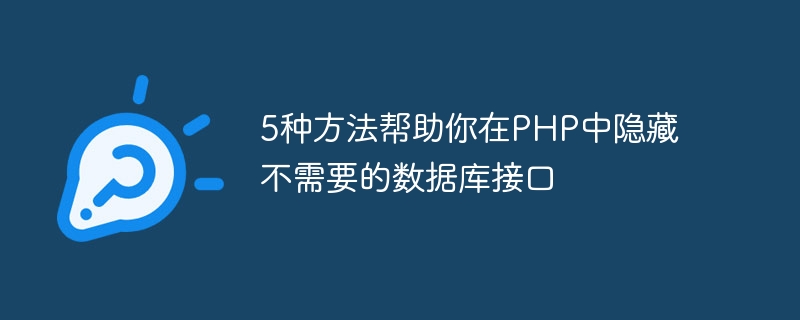Home >Backend Development >PHP Tutorial >5 ways to help you hide unnecessary database interfaces in PHP
5 ways to help you hide unnecessary database interfaces in PHP
- 王林Original
- 2024-03-11 12:33:03977browse

With the rapid development of the Internet, PHP, as a popular server-side scripting language, is widely used in website development and database operations. In PHP, the database interface is a very important part, but sometimes we need to hide some interfaces that do not need to be exposed to the outside world to enhance the security of the system. This article will introduce 5 methods to help you hide unnecessary database interfaces in PHP, while providing specific code examples.
1. Use namespaces
Namespaces are a method used in PHP to solve class name conflicts. They can also be used to isolate database interfaces that do not need to be exposed. Database interfaces that do not need to be exposed to the outside world can be effectively hidden by placing them in a specific namespace. Here is a simple example:
<?php
namespace AppDatabase;
class Connection {
//数据库连接代码
}2. Using object-oriented programming
Object-oriented programming is a commonly used programming paradigm in PHP, which allows for better organization by defining classes and objects Code and hidden details. By encapsulating database interfaces in classes and restricting access rights, you can effectively hide these interfaces. The following is an example of using object-oriented programming:
<?php
class Database {
private $connection;
public function __construct() {
//数据库连接代码
}
//其他数据库操作方法
}3. Using access control modifiers
PHP provides three access control modifiers: public, protected and private. Use these modifiers appropriately to restrict access to database interfaces. Marking interfaces that do not need to be exposed to the public as private can effectively hide these interfaces. The following is an example of using the private modifier:
<?php
class Database {
private $connection;
public function __construct() {
//数据库连接代码
}
private function query($sql) {
//查询方法
}
}4. Using the interface
The interface is a specification used to define methods in PHP. By implementing the interface, you can implement the class decoupling between. Defining database interfaces that do not need to be exposed to the outside world in the interface, and then implementing the interface in the class can effectively hide these interfaces. The following is an example of using an interface:
<?php
interface DatabaseInterface {
public function connect();
public function query($sql);
}
class Database implements DatabaseInterface {
public function connect() {
//连接数据库方法
}
public function query($sql) {
//查询方法
}
}5. Using closure functions
The closure function is an implementation of anonymous functions in PHP. By using the closure function, you can Encapsulate some database operations and call them when needed. Encapsulating database interfaces that do not need to be exposed to the outside world in closure functions can effectively hide these interfaces. The following is an example of using a closure function:
<?php
$database = function() {
$connection = new PDO('mysql:host=localhost;dbname=database', 'username', 'password');
return $connection;
};
//在需要时调用闭包函数
$connection = $database();Through the above 5 methods, you can help you hide unnecessary database interfaces in PHP and enhance the security of the system. Of course, there are other more complex ways to achieve interface hiding, which requires choosing the most suitable method based on specific project needs and circumstances. I hope the content of this article is helpful to you!
The above is the detailed content of 5 ways to help you hide unnecessary database interfaces in PHP. For more information, please follow other related articles on the PHP Chinese website!

